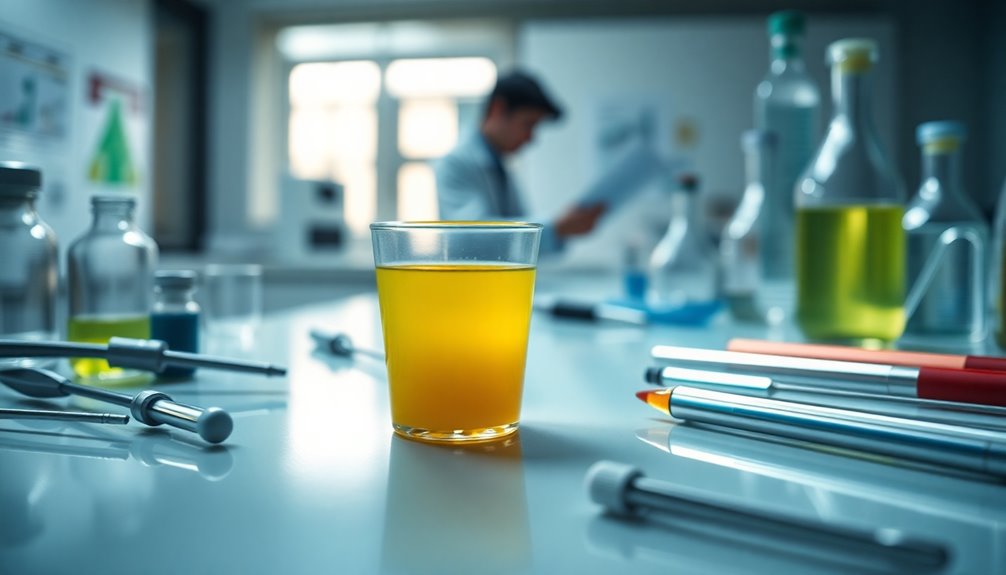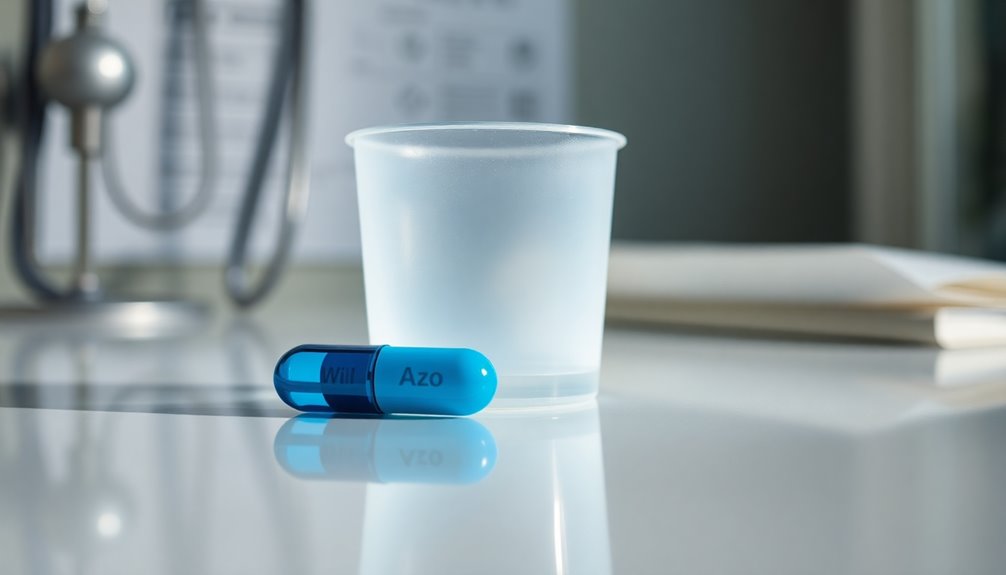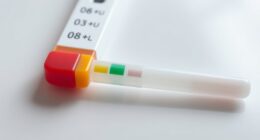To reduce acne scars, you can try topical treatments like retinoids, vitamin C, or glycolic acid to boost collagen and exfoliate skin. Minimally invasive options such as microneedling, chemical peels, or subcision target scar tissue, while laser and light therapies promote skin renewal with minimal downtime. For deeper scars, surgical procedures may be necessary. With so many options, understanding which suits your skin type can help you achieve smoother skin—exploring more will guide you further.
Key Takeaways
- Treatments include topical agents, minimally invasive procedures, and surgical options tailored to scar type and skin sensitivity.
- Topical treatments like retinoids, vitamin C, and silicone gels can improve scars with consistent application.
- Laser, light therapies, and chemical peels stimulate collagen and skin renewal for smoother skin.
- Deep or resistant scars may require surgical interventions such as punch excision or subcision.
- Consulting a dermatologist ensures personalized treatment plans, maximizing effectiveness and minimizing risks.
Understanding the Causes of Acne Scars

Understanding what causes acne scars is key to effectively treating them. When you develop acne, your body responds by producing collagen to heal the skin. If this process goes awry—either producing too little or too much collagen—you end up with scars. Inflammatory acne, like cysts and nodules, causes more damage to the skin’s deeper layers, increasing scarring risk. Picking or squeezing pimples worsens the problem by inflaming the skin and disrupting healing. Genetics also play a role; some people’s skin heals differently, making scarring more likely. Additionally, factors like delayed treatment or untreated severe acne can lead to more noticeable scars. Understanding these causes helps you recognize why scars form and guides you toward effective prevention and treatment strategies. Using advanced treatments such as clinical procedures can also help minimize scarring and promote healthier skin.
Types of Acne Scars and Their Characteristics
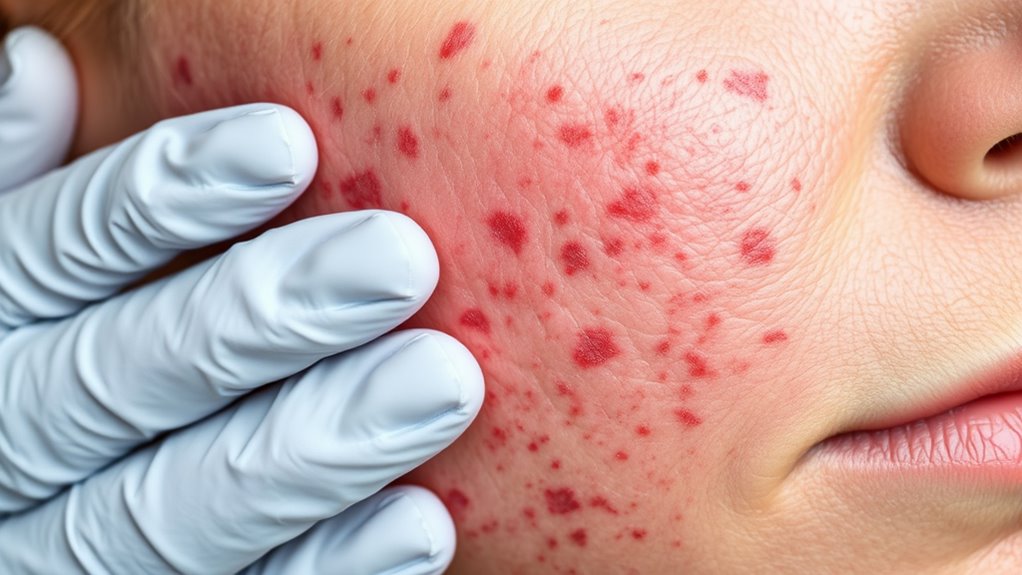
Acne scars come in various forms, each with distinct features that influence treatment options. Atrophic scars, such as icepick, boxcar, and rolling scars, create depressions in your skin, often resulting from collagen loss. Icepick scars are narrow and deep, resembling small holes, while boxcar scars are wider with sharp edges, giving a pitted appearance. Rolling scars appear as wave-like undulations, caused by tethered skin. Hypertrophic scars, on the other hand, are raised, thickened bumps that form due to excess collagen. Keloids are similar but extend beyond the original wound, creating thick, overgrown scars. Recognizing these types helps determine the most effective treatment, as each requires a tailored approach to improve your skin’s texture and appearance. Advances in machine learning technology are also contributing to more precise diagnostic tools for assessing scar types and planning treatments.
Topical Treatments for Reducing Scars

Topical treatments can help lighten scars and improve skin texture, but their ingredients and effectiveness vary. It’s important to choose products that suit your skin type and understand how to apply them safely. Knowing the right ingredients and proper usage can make a real difference in your scar reduction journey. Incorporating products with pressure relief properties may also enhance comfort during treatment.
Ingredients and Effectiveness
Many topical treatments for acne scars contain ingredients that aim to boost collagen production, promote skin cell turnover, or reduce inflammation. Ingredients like retinoids encourage cell renewal and help smooth out rough scars over time. Vitamin C is another popular ingredient because it stimulates collagen synthesis and brightens skin, making scars less noticeable. Alpha hydroxy acids (AHAs), such as glycolic acid, exfoliate dead skin cells, revealing fresh skin underneath and improving texture. Silicone gels and sheets can hydrate and soften scars, reducing redness and size. While these ingredients can improve the appearance of scars, their effectiveness varies based on scar type and consistency of use. Combining ingredients often yields better results, but patience is key, as topical treatments typically take weeks to show noticeable improvements.
Application and Safety
Applying treatments correctly and safely is essential to achieving the best results while minimizing risks. Always follow the instructions on the product label, and do a patch test first to check for irritation. Cleanse your skin thoroughly before applying any topical treatment, and avoid overusing products, which can cause irritation or dryness. Use a gentle touch and apply only to the scarred areas. Store treatments in a cool, dry place away from direct sunlight. Here’s a quick guide:
| Tip | Why it matters |
|---|---|
| Follow instructions carefully | Prevents adverse reactions |
| Use a patch test | Ensures your skin tolerates the product |
| Clean skin before application | Enhances absorption and efficacy |
| Don’t overuse products | Minimizes irritation and side effects |
A thorough understanding of topical treatments can help optimize scar reduction and ensure safety during use.
Minimally Invasive Procedures and Their Benefits

Minimally invasive procedures offer an effective way to improve acne scars without the downtime associated with more aggressive treatments. These options typically involve small instruments or techniques that target scar tissue directly. You’ll notice less discomfort and quicker recovery times, making them ideal if you want noticeable results with minimal disruption to your routine. Procedures like microneedling, chemical peels, or subcision stimulate collagen production and break down scar tissue, leading to smoother skin. They are also customizable based on your scar type and skin condition. While results may take some time to fully develop, you benefit from a safer, lower-risk approach that can be repeated or combined with other treatments. These procedures provide an accessible, effective way to enhance your skin’s appearance without significant downtime. Exploring skin treatment options can help you choose the best approach for your specific needs.
Laser and Light-Based Therapies
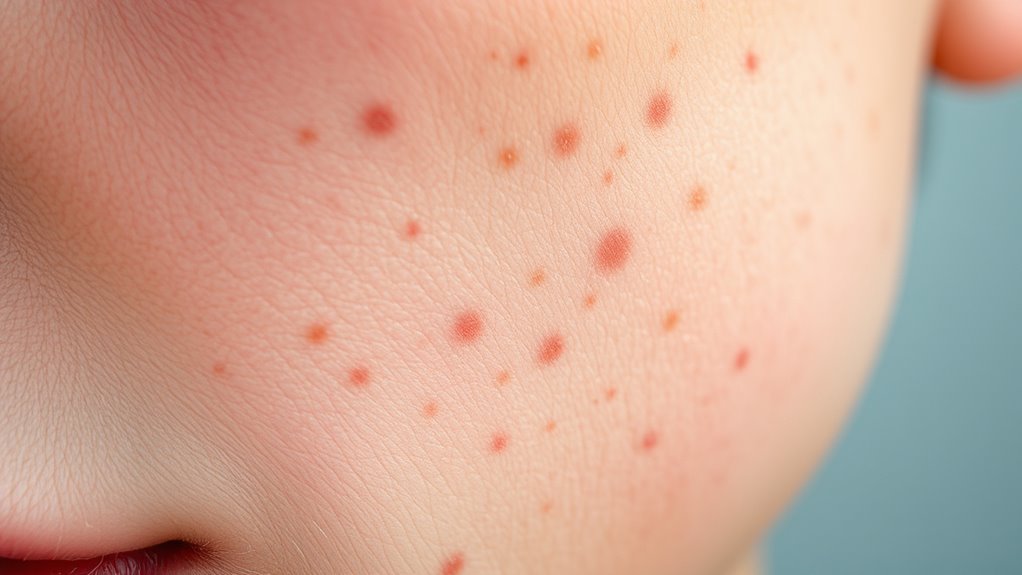
Laser and light-based therapies target your scars with focused energy to stimulate skin renewal. Different types of light treatments offer varying results and risks, so understanding how they work is essential. We’ll explore what you can expect from these procedures and how to weigh their benefits against potential side effects.
How Laser Treatments Work
Laser and light-based therapies work by using targeted beams of light to stimulate your skin’s natural healing process. The laser heats specific layers of skin, encouraging collagen production and skin renewal. This process helps smooth out scars and improve skin texture. Different lasers target various skin depths and concerns, allowing for precise treatment. Incorporating advanced technology ensures more effective and safer procedures for patients.
Types of Light Therapies
Light therapies for acne scars include a variety of laser and non-laser options designed to target specific skin concerns. Laser treatments, like fractional CO2 or Erbium lasers, stimulate collagen production by creating micro-injuries that encourage healing. Non-laser light therapies, such as blue and red LED light, work differently; blue light kills acne-causing bacteria, while red light reduces inflammation and promotes healing. You might also encounter intense pulsed light (IPL) therapy, which uses broad-spectrum light to improve skin texture and tone. These therapies are generally non-invasive and require minimal downtime. They can be tailored to your skin’s needs, making them versatile options for reducing scars and enhancing skin appearance. Additionally, AI-powered personalization can help customize treatment plans based on individual skin responses and goals. Always consult a professional to determine the best light therapy for your specific scar type and skin condition.
Expected Results and Risks
While these therapies can considerably improve the appearance of acne scars, you should also be aware of the expected results and potential risks involved. Typically, you may see smoother skin and reduced scar visibility after several sessions. However, results vary based on scar type and treatment intensity. Risks include temporary redness, swelling, or discomfort, which usually subside quickly. In rare cases, you could experience pigmentation changes or scarring. Consider the following:
| Expected Results | Potential Risks |
|---|---|
| Smoother, more even skin tone | Redness and swelling, temporary |
| Reduced scar depth over time | Hyperpigmentation or hypopigmentation |
| Gradual improvement with multiple sessions | Risk of scarring if not performed properly |
Additionally, understanding how laser and light-based therapies operate can help set realistic expectations for treatment outcomes.
Surgical Options for Deep Scars

Surgical options for deep acne scars offer targeted solutions when less invasive treatments aren’t effective. You might consider procedures like punch excision, where your dermatologist removes the scar tissue and stitches the skin back together, or subcision, which involves releasing the scar from underlying tissue to elevate it. These techniques are particularly useful for deep, pitted scars that don’t respond to creams or laser treatments. You may experience some swelling, redness, or minor discomfort afterward, but these usually subside quickly. Surgical options can provide significant improvement, restoring smoother skin. Keep in mind, multiple sessions might be necessary, and there’s a small risk of infection or further scarring. Consulting a specialist can help determine if surgery is the right choice for your specific scars, especially if you need to understand the hours of operation at your local clinics or centers.
Choosing the Right Treatment for Your Skin Type
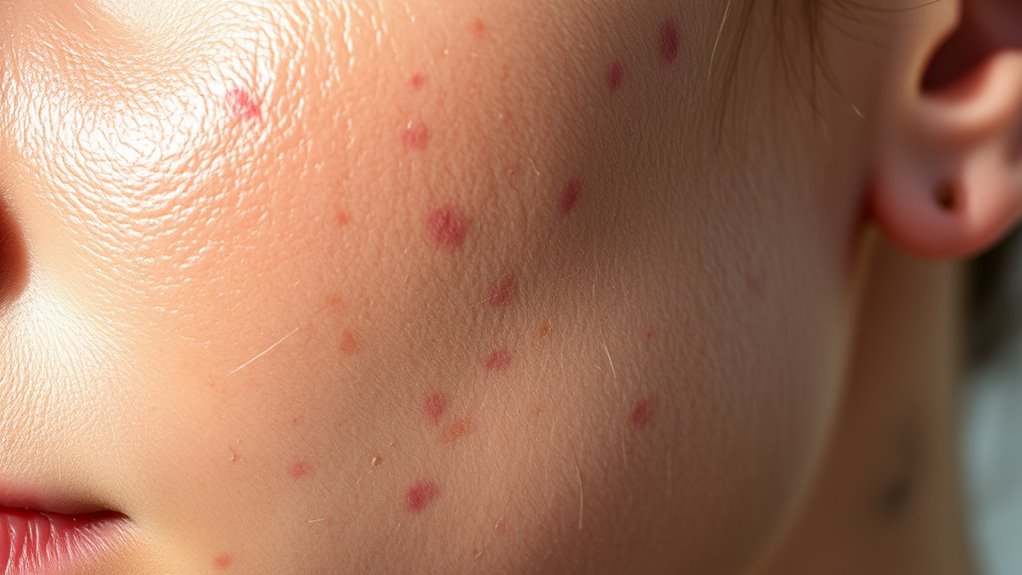
Choosing the right acne scar treatment depends on your skin type, as different treatments work better for certain skin textures and sensitivities. If your skin is sensitive or prone to redness, gentle options like chemical peels or microneedling might suit you best. For oily or thicker skin, laser resurfacing or deeper chemical peels can be more effective. Dry or delicate skin may respond better to treatments that promote hydration and healing, such as low-intensity laser therapy or certain topical treatments. Additionally, understanding how automation in business can improve treatment delivery and patient care can help in selecting the most effective approach. Always consider your skin’s response to previous procedures and consult a dermatologist before starting any treatment. By understanding your skin’s unique needs, you can choose a safer, more effective option that minimizes side effects and helps you achieve smoother, healthier-looking skin.
Frequently Asked Questions
How Long Does It Take to See Results From Acne Scar Treatments?
When you start acne scar treatments, you might wonder how long before you see results. Typically, you’ll notice improvements within a few weeks, but full results often take three to six months. It depends on the treatment type and your skin’s response. Consistency is key, so follow your dermatologist’s advice closely. Keep in mind, some treatments need multiple sessions to achieve the best outcomes.
Are There Any Side Effects Associated With Laser Therapy?
Laser therapy can be effective for reducing acne scars, but you should be aware of potential side effects. You might experience redness, swelling, or mild discomfort after the procedure. Some people notice temporary skin discoloration or sensitivity. Less commonly, there’s a risk of scarring or infections if not performed properly. Make sure to follow your dermatologist’s aftercare instructions to minimize side effects and promote ideal healing.
Can Natural Remedies Effectively Improve Acne Scars?
You wonder if natural remedies can really improve acne scars. While some people find that ingredients like honey, aloe vera, or lemon juice help soothe skin and reduce scars, scientific evidence supporting their effectiveness is limited. These remedies might offer mild improvements, but they usually can’t replace proven treatments like laser therapy or chemical peels. For best results, consider consulting a dermatologist to explore safe, effective options tailored to your skin.
How Much Do Acne Scar Treatments Typically Cost?
Did you know that the average cost of acne scar treatments ranges from $200 to $3,000? You might wonder how much you’ll need to invest. Treatments like laser therapy and chemical peels typically cost between $500 and $2,500 per session, while microneedling is often around $300 to $700. Keep in mind, multiple sessions are usually needed, so costs can add up. Be sure to consult with a dermatologist to find the best option for your budget.
Are Certain Skincare Products Better for Preventing Future Scars?
You want to prevent future scars, so choosing the right skincare products is key. Look for products with ingredients like retinoids, which boost cell turnover, or salicylic acid, to clear pores and reduce inflammation. Sunscreen is also essential, as UV exposure can worsen scars. Consistent use of these products helps protect your skin and minimizes the risk of new scars forming over time.
Conclusion
Understanding your acne scars and available treatments can boost your confidence. Did you know that over 80% of people with acne experience scarring at some point? Luckily, with the right approach—from topical solutions to advanced procedures—you can markedly improve your skin’s appearance. Don’t let scars define you; explore your options and take action today. Your clear, smooth skin is within reach—start your journey to confidence now.


